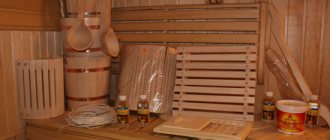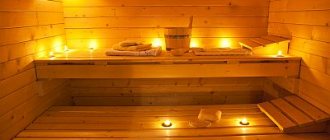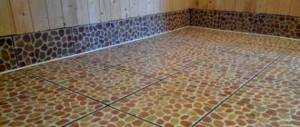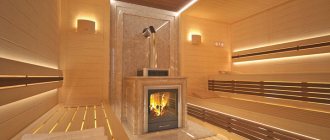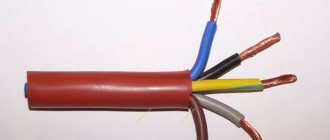Rules
Electrical wiring in a bathhouse is naturally different from wiring in a residential building. The room closest to the requirements is the bathroom. It also has high humidity , but the temperatures, of course, are different.
However, even in a bathhouse, not all rooms are equally problematic from an electrician’s point of view. So we would call the steam room and washing room the most “problematic”. The rest room, dressing room, bathroom and veranda do not require increased protection of wiring and devices.
Once we have already made detailed excerpts from the PUE, which mention baths, saunas or washrooms. Therefore, now we will limit ourselves to a rather condensed retelling of the rules for electrical wiring in a bathhouse.
Let's start with the location of the electrical panel. It is advisable to place it indoors and not outdoors. In this case, it is necessary to either use a dry room or ensure complete waterproofing of the shield. No pipelines (water supply, gas pipeline, sewerage) should pass near the switchboard.
the installation of an RCD is considered mandatory for wet rooms.
Wires should be led:
- (preferably, not necessarily) hidden in the steam room and washing room;
- open on the wooden walls of other rooms.
IMPORTANT! However, it should be remembered that in a steam room it is not advisable to run wires along the walls, even inside. The right thing to do is to make a through hole with a metal sleeve in the wall, through which the wires for the lamp go into the steam room.
The wires leading to the steam room must be made heat-resistant - with insulation made of silicone rubber - RKGM, PRKS.
The ban on metal sleeves and corrugation applies only to steam rooms and washing rooms.
Wires can only by welding, crimping, soldering or a similar method.
Switches and sockets should be located outside the steam room and washing room.
complete list of rules for wiring in a bathhouse and steam room at the link already given above.
Choosing the right insulation: review of materials
During the construction and operation of a bath structure, the choice of material for further work plays an important role. In addition to thermal insulation, it is worth taking care of purchasing hydro- and vapor barrier materials, with the help of which a favorable microclimate is created in the premises.
Insulation for baths and saunas is presented on the construction market in various versions. Let's look at popular solutions.
Foil/Foil paper
This vapor barrier consists of special kraft paper, on which a thin layer of aluminum foil is applied. It is installed in steam rooms, because the material prevents the appearance of dampness and mold, and also perfectly retains heat indoors. The foil has a 100% reflective effect.
The products are fixed inside the structure so that they are in full contact with the insulation. During installation, a special gap is left - from 20 to 50 mm - between the vapor barrier layer and the sheathing. The main thing is to seal the seams.
Mineral wool/mineral board
An important advantage of insulation is its high resistance to the influence of chemicals and high temperatures. The cost of the products is reasonable, but mineral wool has a lot of disadvantages. Such thermal insulation is heavy, has low strength and is often prone to rotting processes.
Polyethylene film
Such products are used to insulate the under-roof space. Films come in two versions: with perforation (to prevent moisture from getting inside) and without perforation (to ensure reliable vapor barrier). A special gap is left above the insulation for ventilation.
A popular solution is laminated films equipped with foil. Polyethylene films are used for vapor barrier in bathhouses. When installing, the main thing to remember is that the parts are connected to each other and to the rest of the structure.
Polypropylene (PP) film
The products are characterized by strength and resistance to sunlight. Films with special reinforcement are now popular. In production, such material is covered with a layer of anti-condensation, which is made from viscose and cellulose fibers. These special films are mounted only with the rough surface facing down and the other surface facing up. A small gap is left between the film and the insulation.
Fiberglass insulation
Fiberglass is non-toxic, tolerates high temperatures (convenient for steam rooms), and is not affected by chemicals or various atmospheric influences. The building material has long fibers, which provides elasticity and high elasticity. They are sold in rolls and slabs.
Polyethylene foam (PPE)
Also known as Izolon, it is designed for reliable insulation of wall structures and pipelines. It is used in partitions and foundations, and also as a thermal insulation material for window systems. Izolon also insulates prefabricated elements of various buildings.
PPE is produced in production with or without foil coating. It is highly reflective, and the products are easy to install: construction tape or staples, welding or glue. Available in rolls or sheets.
Expanded polystyrene concrete (PSB)
PSB is a version of lightweight concrete. This building material consists of polystyrene granules and Portland cement. The functions of the product are similar to concrete, which has a cellular structure. Advantages: low level of moisture absorption, ideal solution for insulating partitions and wall structures.
Expanded polystyrene (PPS)
PPS is used for external and internal thermal insulation. The product is not afraid of moisture and at the same time retains its beneficial properties. The building material is light weight, durable and environmentally friendly. Among the disadvantages: low level of steam passage and poor sound and sound insulation.
Electricity in the bathhouse: consumer groups
Consumer groups are arbitrary groups of devices that are powered by current. They are arbitrary because it depends on your choice (or on the choice of an electrician) on what basis you will group devices.
There are two options:
- or group by room - all consumers of a relaxation room, steam room, washing room, for example;
- or by uniformity - all sockets, all lamps, all power plants.
ADVICE! Mark the names of consumer groups using labels attached to the wires and labeled.
In our diagrams you will find a division into the following groups: lamps, sockets and power units.
Let us explain that the last group includes devices with high electricity consumption. In the bathhouse these are most often electric ovens and washing machines.
Installation of corrugations for a chimney
The assembly of this simple structure must be done in the following order:
- Choose a location for the heating unit so that the chimney is straight and vertical. This means that along its path the chimney should not encounter any obstacles that must be bypassed. This mainly concerns transfers on the interfloor ceiling and rafter system.
- Install the elbow at the outlet of the boiler or gas water heater. Instead, flexible corrugation made of aluminum or stainless steel can be used. It should be noted that this area is almost never insulated from the outside, since the temperature of the furnace gases in this place is high and condensation does not form.
- Next, the straight section is installed with the installation of clamps and fastening to brackets (for a wall-mounted chimney).
- It is advisable to make the outer part, rising above the roof, from an insulated sandwich pipe; if necessary, install guy wires made of stainless or galvanized wire.
- Install a safety device in the form of a cap on the pipe.
- Install a condensate trap.
Important! To ensure that condensate is collected and prevented from getting back into the firebox, the vertical part of the chimney cannot be placed directly above it.
Wiring: what does it consist of?
The main electrical wiring components in a bathhouse are the following:
- input cable;
- electrical panel;
- grounding;
- indoor cables;
- lamps;
- sockets
- Inside the electrical panel there are the following elements: cables;
- tires;
- RCD;
- circuit breakers;
- differential automatic machines;
- transformer.
The input cable can have 3 or 5 cores , and transmit current with a voltage of 220 or 380 volts.
ATTENTION! Grounding is required. Read about how to do it here.
You will find information about what parameters the components must meet in the same article.
There is a difference in a bathhouse and a steam room
We have already said above that the wiring in the steam room differs in a number of important points from the electrical wiring in the bathhouse.
ADVICE! It will be easiest for those bathhouse owners who already included the wiring in the construction project. Because this is the only way compliance with standards will not be a matter of chance.
In the steam room
Electrical wiring in the steam room: no wires
there are no wires - they go from the outside, and go inside exclusively to connect the lamps.
The question arises: is it necessary to use more expensive heat-resistant wires for electrical wiring in the steam room of a bathhouse? For those who have no way out and have to conduct wiring inside the walls of the steam room - yes, definitely. If you follow the rules - only through the wall to the lamp, then it is a matter of ease of replacing the wire.
The fact is that simple PVC insulation will inevitably collapse in the area that is exposed to high temperatures . This is usually at the wire entrance to the lamp. Therefore, it is recommended to make this area heat-resistant.
In a steam room with an electric oven
The electric furnace is used only in the sauna (because we question the ability of electric furnaces without a steam generator to create a Russian bath mode).
Power calculations are usually done in a simplified manner, based on the cubic capacity of the room, based on the ratio of 1-1.5 kilowatts per cubic meter. Therefore, it is enough for you to proceed from one or one and a half volume of the steam room. Let's assume that a pair room of 1.8*1.4*2.1 (DSHV) is given. Its volume is 5.3 cubic meters. Consequently, the furnace power is from 5 to 8 kW. And this is still a small steam room!
It is clear that such a power plant is not installed on a regular outlet (here the current strength is 23-36 A, and a regular outlet can withstand 10-16 A). The wire is led outside and connected to a power outlet (they come in different capacities).
Heat-resistant wires of the required cross-section are included with the stove itself , so you just need to take them out and connect them.
BY THE WAY! A grounding plug requires a ground connection to the outlet, this is not new, is it?
